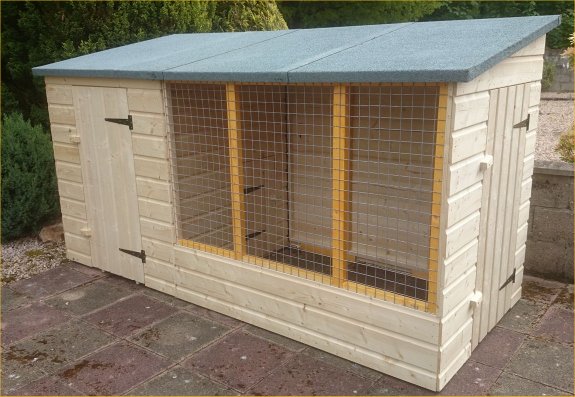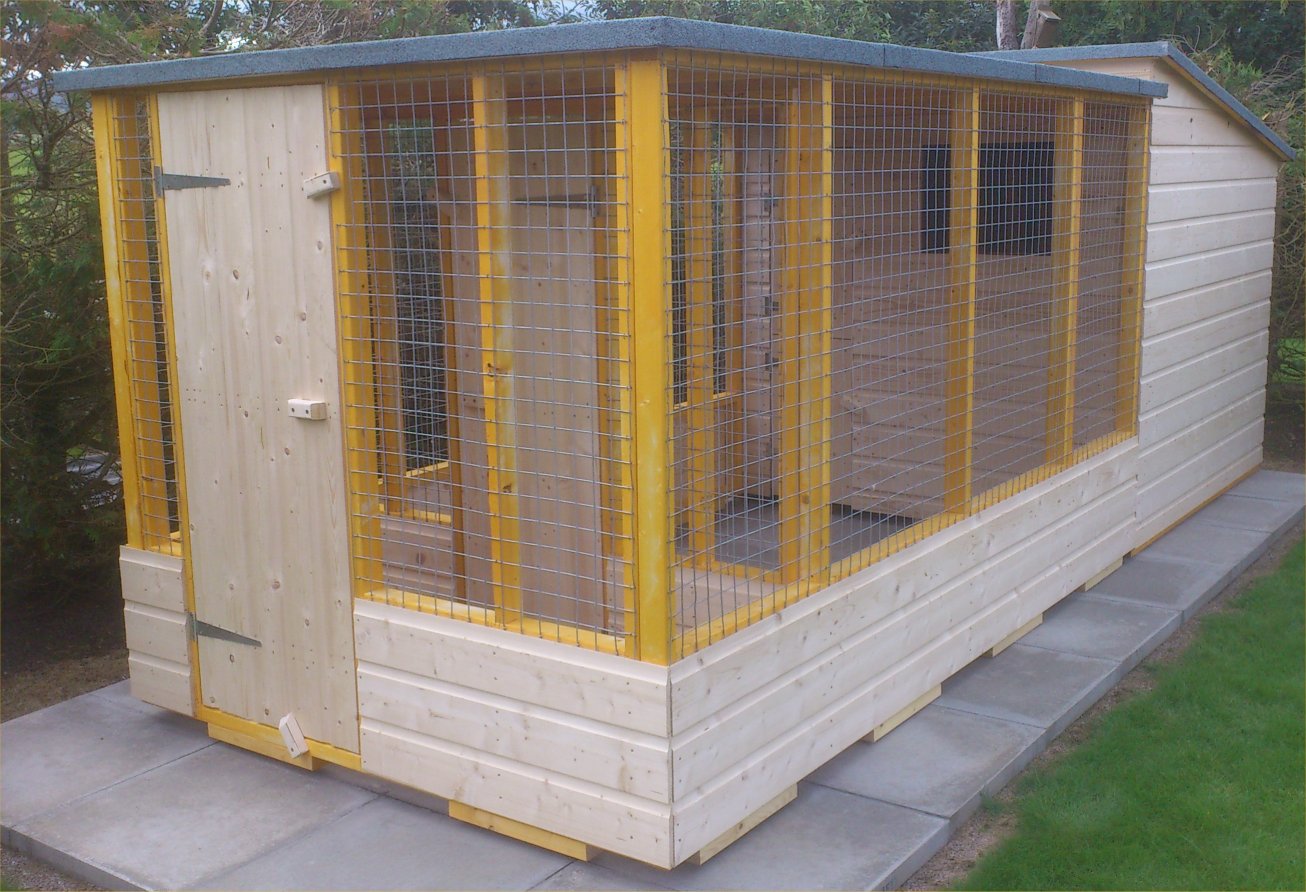It is essential to provide a solid and level
base for "ANY BUILDING".
Attempting to assemble a garden building on an unleveled
or soft
surface will incur difficulties in squaring the building up when putting
on the roof and doors will often not close properly. We recommend
the following 4 types of base:
• A Paving Slab Base - We can supply drawings for slab positions
free of charge if you require them.
• A Concrete Base
• Tantalized Bearers
• A pre-formed base – A relatively new concept in shed
bases, a pre-manufactured tanalised timber frame base, all you have to do
is level it for the building to sit on. These are available for different
sizes of sheds. Ask for a quotation if you feel that this would be the
easiest method for you....Available for all sheds and buildings up to 6 ft
x 10 ft apart from dog sheds with runs....... Dog
sheds and animal housing must
be on either a slab base or a concreted area for
hygiene purposes.
Whichever method is more suitable, we strongly recommend that your base be
made to the same measurements as the floor of the garden building you are
contemplating purchasing.
This allows the majority of rain to run off the
walls and roof and soak-away instead of pooling on the base under the
building and effectively creating dampness and potential rot problems.
Concrete Base
Tools Required:
• Pegs and string
• Sand and aggregate
mix
• Hardcore
• Standard cement
• Timber for shuttering formwork
• Tape measure
• Spade
• Sweeping brush
• Cement mixer
• Wheel barrow
• Tamp board
• Spirit level.
Step 1:
Decide where to position the shed in an optimal space, allow
enough distance from hedges or fences for easy access to all sides.
Using pegs and string to mark out the base the same area as the
building’s floor. Finally, measure diagonals to ensure the area is
square.
Step 2:
A concrete base requires 3 inch (7.5 cm) of compacted hardcore
underneath the 3 inch (7.5 cm) concrete layer. The base can be level
with the ground or raised above it. If it is to be level excavate the
top earth to 6 inch (15 cm) to allow for the hardcore layer and 3 inch
(7.5 cm) thickness of concrete. Level the area with a rake and spade and
remove the pegs.
Step 3:
Set up leveled formwork. This involves measuring, cutting and
fitting timber, to the shape of the base in order to contain the
concrete (as shown in the diagram). Check diagonals to ensure the
formwork is square. And also ensure the formwork is level, as this will
determine whether your base is 100% level. Next, spread a layer of well
compacted hardcore and cover with a liberal amount of sand.
Step 4:
Next, mix concrete using one part cement to five parts aggregate
or use bags of dry-mixed concrete to which you just add water. Small
amounts of water should be added at a time and mixed into the concrete
mix to ensure excessive amounts are not added making the cement sloppy,
as the concrete should be kept on the dry side.
Spread the concrete evenly and slightly proud of the formwork. This can
be then leveled off with a long straight edge of timber resting on the
formwork using a sawing motion slowly over the entire surface of the
freshly laid concrete.
If wet weather is forecast, cover the concrete with polythene for
24-hours. In warm weather cover the base with damp sacks and sprinkle
them with water over the 24-hour period, this will ensure the drying
concrete will not shrink and crack.
The result is a smooth, sound, level base. The perfect foundation for
the construction of a garden building. Allow at least 4 - 5 days
for the concrete to set prior to assembling your building.
Please note however....Large concreted areas to be used as
garage or workshop floors, should be left at least 14 days before the
building is erected on it to ensure a secure fixing for the building.
Slab Base
Tools Required:
• Pegs and string
• Flat Face Paving Slabs
• Sharp sand
• Standard cement, rake
• Tape measure
• Spade
• Rubber mallet
• Sweeping brush
• Spirit level
Step 1:
As mentioned above, decide where to position the shed in an
optimal space. Allow enough distance from hedges or fences for
easy access to all sides. Using pegs and string to mark out the base the
same area as the building’s floor. Finally, measure the diagonals to
ensure the area is square.
Step 2:
Strip the topsoil and dig out to a depth of approx. 2.5 inch (7
cm) to accommodate the base. Level the area and remove the pegs.
Step 3:
Mix together one part cement to eight parts building sand for a
dry sand and cement mix. Spread this evenly ensuring that the mix sits
approx. 4 cm in depth. Now, rake this to a level.
Step 4:
Starting from one corner and working outward, lay the slabs by
tapping down on the centre of each slab with a rubber mallet. Using a
spirit level, ensure all the slabs are square, level and firmly butted
together for a solid base.
Step 5:
The completed base should now be level and
square. Do one final check with a long straight edge to check if the
base is level from each corner, and also measure the diagonals to
finally check the base is square. Brush off any excess dry sand/cement
mix, which could hinder the leveling of the shed. The result is a
smooth, sound, level base. The perfect foundation for the construction
of a garden building.
Tanalised Bearers Base
Tools Required:
• Pegs and string
• Tape measure
• Spade
• Rubber mallet
• Spirit level
• Hardcore
• 75mm x 75mm Tanalised Bearers
Step 1:
As mentioned above, decide where to position the shed in an
optimal space. Allow enough distance from hedges or fences for
easy access to all sides. Using pegs and string to mark out the base
the same area as the building’s floor. Finally, measure the
diagonals to ensure the area is square.
Step 2:
Strip the topsoil and dig out to a depth of approx. 3 inch
(7.5 cm) to accommodate the base. Level the area and remove the pegs.
Step 3:
Fill the trench with hardcore and compact down as level as
possible.
Step 4:
Lay the bearers on the hardcore, 16 inches (40cm) apart. The
bearers should be laid at 90 degrees to the building’s floor joists,
i.e. if the floor joists run from side to side of the building then
the bearers will need to run the length of the building. Check the
orientation of the floor joists on your building as they do vary from
building to building. Using the spirit level and rubber hammer,
tap the bearers into the hardcore until they are perfectly level.
If you are in any doubt about preparing your foundations
... PLEASE ASK TO
SAVE YOUR SELF TIME AND MONEY
If you would like to have someone to prepare the foundations for you,
we will be happy to supply you with contact numbers of experienced companies we
highly recommend
 !For All Your Timber Garden Building needs!
!For All Your Timber Garden Building needs!
